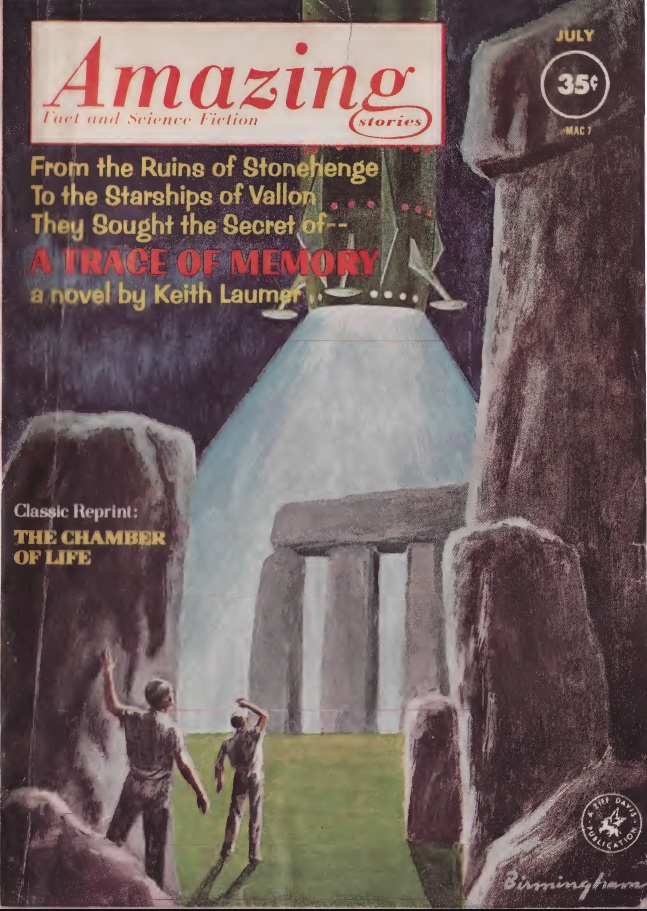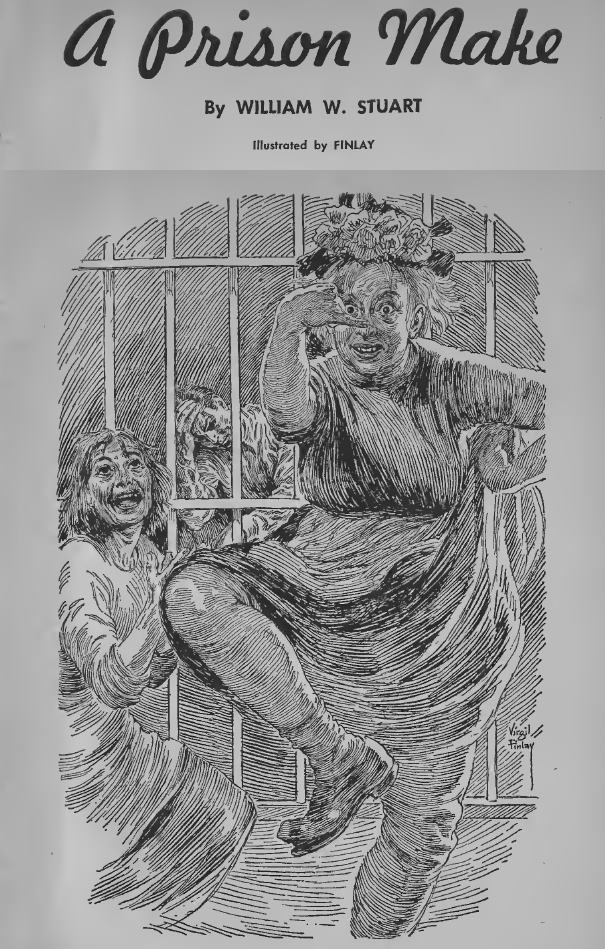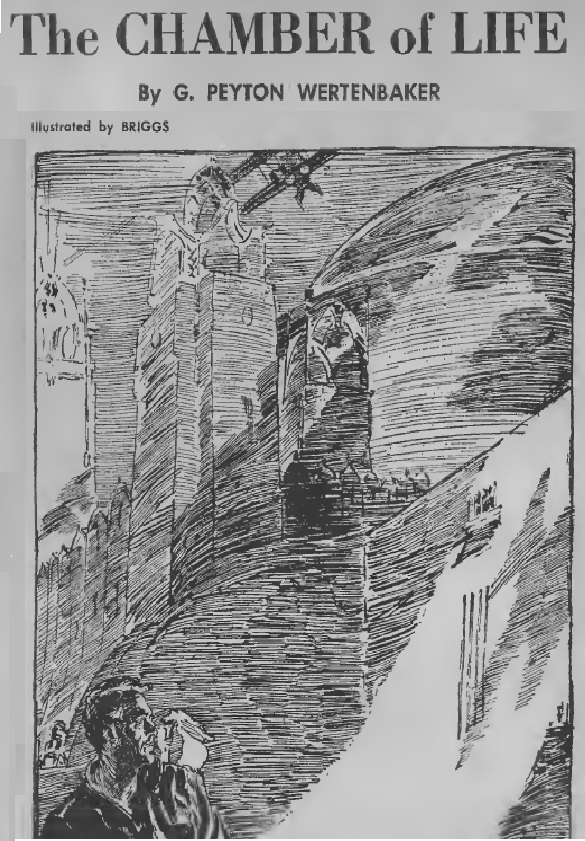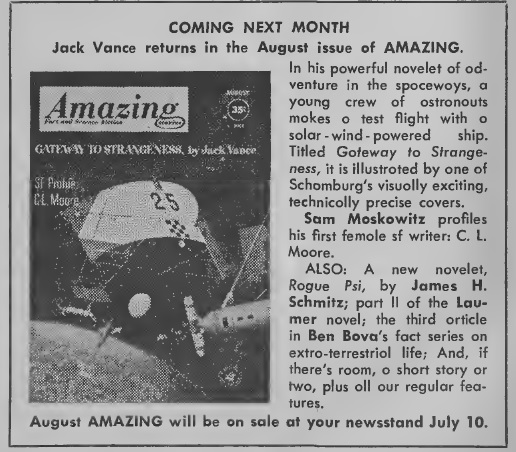
by John Boston

The July Amazing starts off ambiguously, with Stonehenge on the cover—often a bad sign, you could find yourself in Atlantis if you’re not careful. But it illustrates A Trace of Memory, a new serial by the reasonably hardheaded Keith Laumer, so we may be spared any deep wooliness. I’ll defer reading and comment until it’s complete.

So what else is there? Excepting the “Classic Reprint,” this is the Literary Pastiche issue of Amazing. The first of three short stories is The Blonde from Barsoom by Robert F. Young, featuring an aspiring fantasy writer whose work is virtually plagiarized from Edgar Rice Burroughs, as we are shown entirely too clearly. It is vivid, because he has a knack for projecting himself into Burroughs’s world, and it soon enough occurs to him that maybe he could project himself into a more pleasant and less strenuous world. Two stars for this slick but annoying trifle.

Then there is Richard Banks’s The Last Class, a Zola pastiche, which we know because it is subtitled (With Apologies to Emile Zola), and the blurb-writer helpfully adds that Zola wrote a similar story of the same title set just after the Franco-Prussian War. This version is set in a regimented future world where people seem to live underground and get around via matter transmitter, and features a schoolteacher who tells her students about the Twentieth Century, when people were free, and gets caught at it. It’s pretty well done, except that the teacher is referred to throughout as Miss Hippiness because she has big hips. Would anyone refer to a sympathetic male central character as Mr. Beergutty or Mr. Hairybackish? It’s an annoying distraction from an otherwise reasonably commendable story, holding it at three stars.
This Banks—not to be confused with the more established and prolific Raymond E. Banks—has published one prior story in F&SF and one that sounds pretty SFnal (Roboticide Squad) in Ellery Queen’s Mystery Magazine.

In between these two is William W. Stuart’s A Prison Make, in which a guy wakes up in a disgusting institutional setting which proves to be a jail, charged with something that he doesn’t remember—but in this world, law enforcement can rummage around in your mind, and they can damage your memory doing it. He’s got a lawyer—a robot on wheels in very poor repair who doesn’t hold out much hope. The story is about his adjustment to his absurd and outrageous situation, and if it sounds a bit familiar, that’s because it’s a downmarket SF rendition of Kafka’s The Trial. As with the other stories, you don’t have to figure it out on your own, since the blurb-writer refers to it as a “Kafkaesque tale.” Well, if you’re going to steal, steal from the best, or at least the most interesting. This one too is well done if a little heavyhanded in places, but without any stupid missteps like Mr. Banks’s character-naming gaffe. Four stars.
So maybe it’s not such a bad idea to have SF writers emulating great mainstream writers of the past. Who’s next? I hear James Joyce is kind of interesting. Just—please—no more Hemingway. (See Hemingway in Space by Kingsley Amis from last year’s Judith Merril “best of the year” anthology.)
Interestingly, there is no editorial comment other than in the blurbs on the fact that three of the five fiction items here are overtly derived from the work of other authors.

The “Classic Reprint” this month, G. Peyton Wertenbaker’s The Chamber of Life from the October 1929 Amazing, is actually pretty good. Once more we have the nearly omnipresent plot device of this old SF: ordinary guy is invited by scientific genius to check out his invention, and trouble follows. But Wertenbaker could write: he had a plain and understated style which compares well to the clumsier and more stilted diction of some of his contemporaries, and he avoids the tiresome digressions of the recent Buck Rogers epic. Here the invention is the ultimate motion picture: all senses are engaged and the viewer is precipitated into an encompassing hallucinatory world, in this case, a regimented utopian society of the future. This guy was ahead of his time; too bad he hung it up in 1931, after only half a dozen stories. Four stars.

Ben Bova contributes another science article (the second of four, we are told), The Three Requirements of Life in the Solar System, which is better organized and more to the point than the one in the previous issue. The three requirements are a “building block atom” for construction of large molecules, a solvent medium in which large molecules can be built, and an energy exchange reaction. On Earth, these are of course carbon, water, and hydrogen-oxygen respectively. Bova then runs down the possibilities for life on each of the planets (for Mars, “almost certainly”; for Venus, “quite possibly”; Jupiter “might”; and the rest, “probably not” or worse). That “almost certainly” is a surprise; but Bova asserts, “Even the most conservative astronomers will now grudgingly admit that some form of plant life no doubt exists in the greenish areas of the Red Planet.” That’s certainly news to me. Three stars.
Bova’s articles, by the way, are illustrated by Virgil Finlay (unlike Frank Tinsley’s, which had at most diagrams or badly printed photos)—an interesting conjunction. Finlay illustrates this month’s sober rendition with something like a fanged lobster with tentacles (“Artist’s rendition of author’s conception of Jovian sea-creature”), and last month he presented a pageant of DNA, the animal kingdom from trilobite to H. Sapiens overlaid with the double helix, its meticulous detail badly betrayed by Amazing’s mediocre printing.
***
One other item of interest appears in Or So You Say, the letter column: one Julian Reid of Canada takes Mark Clifton to task at great length for the misanthropy of his recent stories in Amazing, and compares them knowledgeably and unfavorably with Clifton’s earlier work. Clifton replies at almost the same length, asserting variously that he was just kidding, he venerates humanity and that’s why he bothers to needle it, and his mail is running fifty to one favorably about those stories.
***
And, looming inescapably, in inexorable pursuit . . . B_______ B_________.

(Don't miss your chance to see the Traveler LIVE via visi-phone, June 17 at 11 AM! A virtual panel, with Q&A, show and tell, and prizes!)


